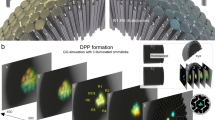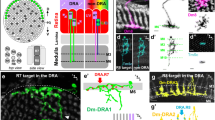Summary
-
1.
In the dorsal retina of the worker bee twisted and non-twisted rhabdoms (resp. retinulae) are analysed by serial LM- and EM-reconstructions. The straight retinulae restricted to the most dorsal 4–5 horizontal rows of ommatidia contain 9 long visual cells, whereas the twisted retinulae are composed of 8 long cells (nos. 1–8) and one basal short visual cell (cell no. 9). The ninth cell and two of the overlying long twisted cells (nos. 1 and 2) are ultraviolet cells (UV cells) which are the only receptors engaged in polarized light detection.
-
2.
By rhabdom geometry two mirror-imaged types of rhabdoms can be discriminated (X- andY-type), which are randomly distributed in the retina. One class of retinulae twists clockwise, the other counterclockwise. The twist rate amounts to about 1°μm−1. The total twist angle is about 180° for the long and about 40° for the small UV cells.
-
3.
In the focal plane of the dorsal part of the retina the microvilli of the long UV cells are all oriented perpendicularly to the horizontalz-axis of the eye. The basal ninth cells replace one of the overlying long UV cells. At their tips, the microvilli are also perpendicularly oriented to thez-axis.
-
4.
By optical analysis polarization sensitivity (PS) and direction for maximum sensitivity (Φmax) are computed for the long as well as for the short UV cells. If the effective birefringence of the rhabdom is very low PS of the long twisted UV cell decreases to unity. However, PS of the short basal UV cells remains pronounced (PS=4.2 for a dichroic ratio of 5 and 7.1 for a dichroic ratio of 10).
As birefringence increases, PS of the long, twisted UV cells increases, but PS of the short ninth cell first decreases to a minimum PS-value of near unity before increasing to high values. We propose the hypothesis that the overall birefringence of the bee's fused rhabdoms is very low (Δn<10−3).
-
5.
For low birefringence the two types of short, ninth cells are maximally sensitive at planes that differ by 36°.
-
6.
Histological as well as optical analysis suggest a minimum model fore-vector detection involving the UV receptors of only two twisted ommatidia: two ninth cells of different twist type act as polarization sensitive channels and the long UV cell(s) as a polarization insensitive channel.
Similar content being viewed by others
References
Autrum, H., Zwehl, V. v.: Die spektrale Empfindlichkeit einzelner Sehzellen des Bienenauges. Z. vergl. Physiol.48, 357–384 (1964)
Bernard, G. D.: Physiological optics of the fused rhabdom. In: Photoreceptor optics (eds. A. W. Snyder, R. Menzel), p. 78–97. Berlin-Heidelberg-New York: Springer 1975
Bernard, G. D., Wehner, R.: Dichroism, birefringence and structural twist in E-vector detectors of insects. Biol. Bull.149, 421 (1975)
Born, M., Wolf, E.: Principles of optics, 3rd ed., p. 708–713. Oxford: Pergamon Press 1965
Clarke, D., Graininger, J. F.: Polarized light and optical measurements. New York: Pergamon Press 1971
Duelli, P.: A fovea for e-vector detection in the eye ofCataglyphis bicolor (Formicidae, Hymenoptera). J. comp. Physiol.102, 43–56 (1975)
Duelli, P., Wehner, R.: The spectral sensitivity of polarized light orientation inCataglyphis bicolor (Formicidae, Hymenoptera). J. comp. Physiol.86, 37–53 (1973)
Eguchi, E.: Fine structure and spectral sensitivities of retinular cells in the dorsal sector of compound eyes in the dragonflyAeschna. Z. vergl. Physiol.71, 201–218 (1971)
Frisch, K. v.: The dance language and orientation of bees. Cambridge, Mass.: Harvard Univ. Press (1967)
Gribakin, F. G.: Cellular basis of colour vision in the honey bee. Nature (Lond.)223, 639–641 (1969)
Gribakin, F. G.: The distribution of the long wave photoreceptors in the compound eye of the honeybee as revealed by selective osmic staining. Vision Res.12, 1225–1230 (1972)
Grundler, O. J.: Elektronenmikroskopische Untersuchungen am Auge der Honigbiene (Apis mellifera), I. Untersuchungen zur Morphologie und Anordnung der neun Retinulazellen in Ommatidien verschiedener Augenbereiche und zur Perzeption linear polarisierten Lichtes. Cytobiol.9, 203–220 (1974)
Hays, D., Goldsmith, T. H.: Microspectrophotometry of the visual pigment of the spider crab,Libinia emarginata. Z. vergl. Physiol.65, 218–232 (1969)
Helversen, O. v., Edrich, W.: Der Polarisationsempfänger im Bienenauge: ein Ultraviolettrezeptor. J. comp. Physiol.94, 33–47 (1974)
Horridge, G. A.: Unit studies on the retina of dragonflies. Z. vergl. Physiol.62, 1–37 (1969)
Kirschfeld, K.: Die notwendige Anzahl von Rezeptoren zur Bestimmung der Richtung des elektrischen Vektors linear polarisierten Lichtes. Z. Naturforsch.27b, 578–579 (1972)
Kolb, G., Autrum, H.: Selektive Adaptation und Pigmentwanderung in den Sehzellen des Bienenauges. J. comp. Physiol.94, 1–6 (1974)
Laughlin, S. B., Horridge, G. A.: Angular sensitivity of retinula cells of dark-adapted worker bee. Z. vergl. Physiol.74, 329–335 (1971)
Menzel, R.: Colour receptors in insects. In: The compound eye and vision of insects (ed. G. A. Horridge), p. 121–153. Oxford: Clarendon Press 1974
Menzel, R.: Optische und elektrische Koppelung im Ommatidium mit fusioniertem Rhabdom. Verh. dtsch. zool. Ges.67, 33–36 (1975a)
Menzel, R.: Polarization sensitivity in insect eyes with fused rhabdoms. In: Photoreceptor optics (eds. A. W. Snyder, R. Menzel), p. 372–387. Berlin-Heidelberg-New York: Springer (1975b)
Menzel, R., Snyder, A. W.: Polarized light detection in the bee,Apis mellifera. J. comp. Physiol.88, 247–270 (1974)
Minke, B., Wu, C. F., Pak, W. C.: Isolation of light-induced response of the central retinula cells from the electroretinogram ofDrosophila. J. comp. Physiol.98, 345–355 (1975)
Ninomiya, N., Tominaga, Y., Kuwabara, M.: The fine structure of the compound eye of a damsel-fly. Z. Zellforsch.98, 17–32 (1969)
Ribi, W. A.: The neurons of the first optic ganglion of the bee (Apis mellifera). Adv. Anat. Embryol. Cell Biol.50, 1–43 (1975)
Roth, H., Menzel, R.: ERG ofFormica polyctena and selective adaptation. In: Information processing in the visual systems of arthropods (ed. R. Wehner), p. 177–181. Berlin-Heidelberg-New York: Springer 1972
Schinz, R.: Structural specialization in the dorsal retina of the bee,Apis mellifera. Cell Tiss. Res.162, 23–34 (1975)
Seitz, G.: Polarisationsoptische Untersuchungen am Auge vonCalliphora erythrocephala. Z. Zellforsch.93, 525–529 (1968)
Snyder, A. W., MeIntyre, P.: Polarization sensitivity of twisted fused rhabdoms. In: Photoreceptor optics (eds. A. W. Snyder, R. Menzel), p. 388–391. Berlin-Heidelberg-New York: Springer (1975)
Snyder, A. W., Pask, C.: Light absorption in the bee photoreceptor. J. opt. Soc. Amer.62, 1267–1277 (1972)
Sommer, E., Wehner, R.: The retina-lamina-projection in the visual system of the bee,Apis mellifera. Cell Tiss. Res.163, 45–61 (1975)
Stark, W. S.: Spectral sensitivity of visual response alterations mediated by interconversions of native and intermediate photopigments inDrosophila. J. comp. Physiol.96, 343–356 (1975)
Stockhammer, K.: Zur Wahrnehmung der Schwingungsrichtung linear polarisierten Lichtes bei Insekten. Z. vergl. Physiol.38, 30–83 (1956)
Täuber, U.: Analyse des Polarisationszustandes des aus dem Rhabdomer austretenden Lichts. J. comp. Physiol.95, 169–183 (1974)
Wehner, R.: Space constancy of the visual world in insects. Fortschr. Zool.23, 148–160 (1975)
Wehner, R.: Structure and function of the peripheral visual pathway in Hymenopterans (in press)
Weiler, R., Huber, M.: The significance of different eye regions for astromenotactic orientation inCataglyphis bicolor (Formicidae, Hymenoptera). In: Information processing in the visual systems of arthropods (ed. R. Wehner), p. 287–293. Berlin-Heidelberg-New York: Springer 1972
Author information
Authors and Affiliations
Rights and permissions
About this article
Cite this article
Wehner, R., Bernard, G.D. & Geiger, E. Twisted and non-twisted rhabdoms and their significance for polarization detection in the bee. J. Comp. Physiol. 104, 225–245 (1975). https://doi.org/10.1007/BF01379050
Received:
Issue Date:
DOI: https://doi.org/10.1007/BF01379050




